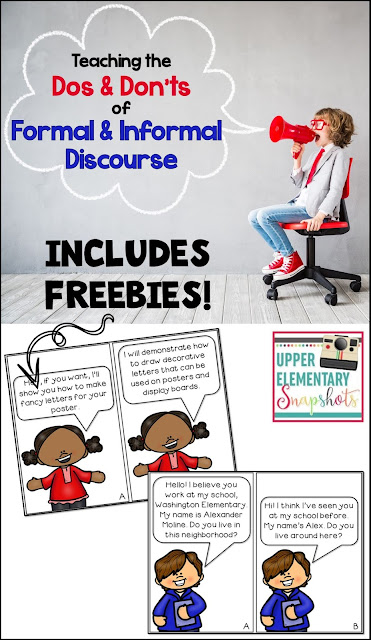Introduction to Formal/Informal Language
I would begin this lesson by using my document camera to display the posters below. After students have read the two speech bubbles, I'd direct them to compare and contrast the two characters' speech with a partner.
Following this partner discussion, I would state that there are two types of English: formal and informal. After defining formal and informal, I would ask students to determine which character used a formal register and which character used an informal register. I would also ask students to guess who the children might have been talking to. (Most students will assume that Boy B is talking to a child, while Boy A is more likely talking to an adult, perhaps a teacher, and that Girl A is conversing with a friend while Girl A is giving a speech or presentation.)
Consider the audience/setting.
The previous discussion will naturally lead into a conversation about the importance of "knowing your audience". The word "audience" refers to the person/people with whom you are speaking or the person/people who will be reading your piece of writing.
Next, I suggest drawing a simple T-chart on your board, and label one side as "Formal English" and the other side as "Informal English". Describe an audience, and have students tell you whether the speaker/writer should use a formal register or an informal register. The image below shows a completed T-chart.
Writing/Speaking for a Formal Audience: The "Rules"
Finally, share the guidelines speakers should follow when speaking/writing for a formal audience.
1. Use formal words.
Example (Formal): We examined the problem and devised a list of possible solutions.
Example (Informal): We looked at the problem and came up with some solutions that might work.
2. Avoid slang.
Example (Formal): I must finish this as soon as possible.
Example (Informal): I gotta finish this ASAP.
3. Avoid contractions.
Example (Formal): I am writing to inquire about your job opening.
Example (Informal): I'm writing to ask about your job opening.
4. Avoid figurative language.
Example (Formal): I believe we need to search for a better solution.
Example (Informal): We are barking up the wrong tree. This isn't going to solve our problem.
5. Use longer, more complex sentences.
Example (Formal): Research has shown that drinking soda, in addition to having negative effects on your teeth and waistline, is also linked to more serious health problems, including diabetes, heart disease, and asthma.
Example (Informal): Drinking too much soda is bad for you. People who drink too much soda often have health problems, such as cavities and heart disease.
Personal Anchor Charts
Teaching your students to follow these tips will assist them in both speaking tasks and writing tasks. You might want to consider creating an anchor chart for your students to refer to as needed. If you are interested in personal anchor charts that your students can glue into a writing or language notebook, click on the images below. They are part of a large set of language anchor charts I have available at each upper elementary grade level.
 |
| This personal anchor chart is included in my 3rd grade set of language anchor charts. |
 |
| This personal anchor chart is included in my 4th grade set of language anchor charts. |







